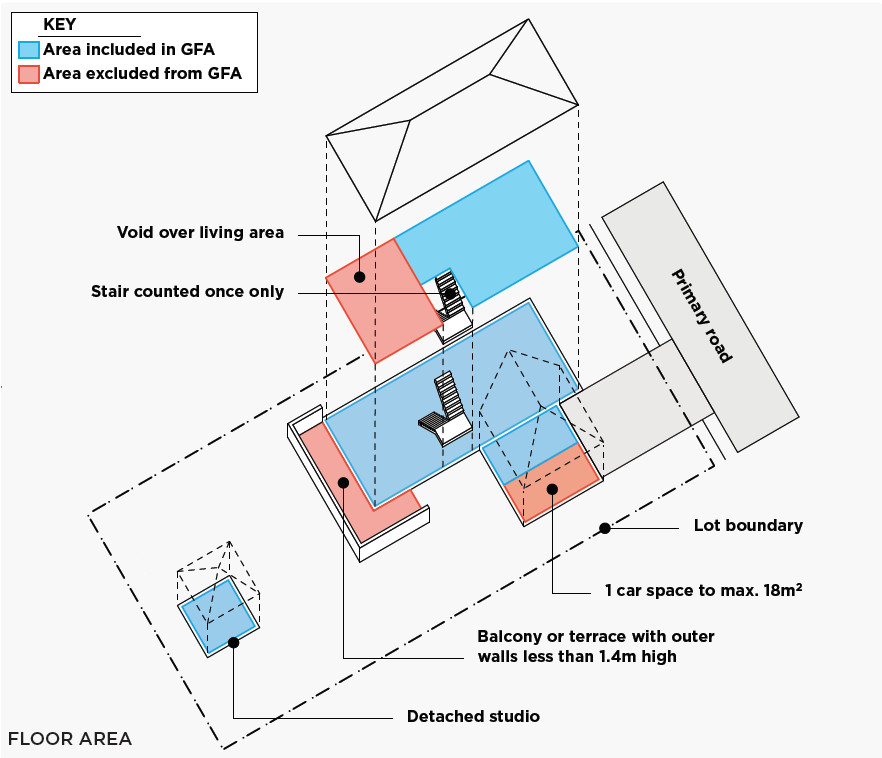Calculating the gross floor area (GFA) is a critical part of the planning process in New South Wales (NSW). The GFA is fundamental to determining the Floor Space Ratio (FSR) for a property, which directly influences the extent of development that can occur on a piece of land. Understanding how to measure GFA accurately is essential for maximizing the development potential of a site.
What is Gross Floor Area?
Gross Floor Area (GFA) is defined as the sum of the floor area of each floor of a building, measured from the internal face of external walls, or the internal face of walls separating the building from any other building. This measurement is taken at a height of 1.4 metres above the floor and includes:
- The area of a mezzanine
- Habitable rooms in a basement or an attic
However, certain areas are specifically excluded from GFA, including:
- Any area for common vertical circulation, such as lifts and stairs
- Any basement areas used for storage, vehicular access, loading areas, garbage, and services
- Plant rooms, lift towers, and other areas used exclusively for mechanical services or ducting
- Car parking to meet any requirements of the consent authority (including access to that car parking)
- Terraces and balconies with outer walls less than 1.4 metres high
- Voids above a floor at the level of a storey or storey above

An extract from Guide to Complying Development – August 2022
NSW Department of Planning and Environment.
GFA Calculation in NSW
When planning a development in New South Wales (NSW), understanding how to calculate the Gross Floor Area (GFA) is crucial to ensure compliance with planning controls like the Floor Space Ratio (FSR). GFA refers to the total floor area within a building, measured from the internal face of external walls, but excludes areas such as car parking, plant rooms, and balconies, depending on specific local council guidelines.
In the accompanying diagram above, you can see a visual breakdown of a two-storey dwelling, where the blue areas represent what is included in the GFA calculation, and the red areas are excluded. For example, the diagram highlights that 1 car space, up to a maximum of 18m², is excluded, along with a balcony or terrace with outer walls less than 1.4 meters in height. Other exclusions include the void on the first floor, and the staircase, which is counted only once on the ground floor rather than being counted on both the ground and first floors. Additionally, the diagram shows a detached studio building, which is included in the GFA calculation.
By referencing the diagram, it becomes clear how specific exclusions and inclusions affect the overall GFA, helping to ensure your project stays within the allowable limits.
What Is Floor Space Ratio?
Floor Space Ratio (FSR) is a critical metric in the planning and development process, particularly in NSW. It represents the ratio of a building’s total gross floor area to the size of the land on which it is built. For example, an FSR of 1:1 means that the total gross floor area of the building can be equivalent to the total area of the site. FSR controls are implemented by local councils to regulate the density and bulk of buildings, ensuring that developments are consistent with the desired character of an area. Understanding FSR is essential for optimizing the design of your home, as it directly influences how much floor space can be achieved on a given site, impacting everything from room sizes to overall building layout.
Example of Calculating Floor Space Ratio (FSR) with Gross Floor Area
To understand how Floor Space Ratio (FSR) works, let’s look at a practical example. Imagine you have a site that is 500 square meters in size. If the local council’s FSR control for that area is 0.5:1, this means that the gross floor area (GFA) of any building on that site can be up to 0.5 times the site area.
Here’s how you would calculate it:
- Site Area: 500 square meters
- FSR: 0.5:1
To calculate the maximum allowable gross floor area:
Maximum GFA = Site Area x FSR
Maximum Area = 500m² x 0.5 = 250m²
In this example, the maximum gross floor area you can build on this 500 sqm site is 250 sqm. This GFA can be distributed across multiple storeys, but the total floor area of all levels combined must not exceed 250 sqm.
Key Considerations for Calculating GFA in Residential Developments
- Semi-Enclosed Balconies (Winter Gardens):
- Semi-enclosed balconies with closeable windows or louvres are generally considered part of the GFA. However, balconies that remain permanently open to the elements, with no potential to be enclosed, may be excluded.
- Corridors and Breezeways:
- In residential developments, corridors and breezeways exposed to the elements and not fully enclosed may be excluded from the GFA calculation. These areas must have a meaningful degree of openness to be considered external spaces.
- Vertical Circulation (Stairs and Lifts):
- In residential buildings, internal stairs and lifts that are not shared between multiple dwellings are usually included in the GFA calculation. However, only every alternate flight of stairs is typically counted, as the other levels are excluded as voids. Stairs leading to non-habitable spaces like attics may be excluded from GFA.
- Car Parking:
- Car parking areas required by the consent authority, including access to those areas, are excluded from the GFA. However, if additional parking spaces are provided beyond what is required, those additional areas will be included in the GFA.
- Non-Habitable Rooms in Basements or Attics:
- Only habitable rooms in basements or attics are included in the GFA. Non-habitable spaces, such as storage rooms or utility areas, are excluded.
CDC vs. DA: Understanding the Differences
When it comes to Complying Development Certificates (CDC) versus Development Applications (DA), the definition of GFA under CDCs has been updated to align more closely with the definitions used by most councils for DAs. This means that the inclusions and exclusions for GFA are generally the same under both pathways. However, a key difference arises in developments that include granny flats. In these cases, the control under a CDC does not relate to GFA but rather to the floor area, which is calculated to the external face of external walls instead of the inside face. This distinction can impact the overall allowable size of the granny flat and should be carefully considered during the design and approval process.
What This Means for Your Build
When comparing the Gross Floor Area (GFA) to the actual built area of a home, there is often a significant difference. In our analysis of 15 homes, which included a mix of two-storey dwellings, single-storey homes, and acreage designs, we found that
the actual built area tends to exceed the GFA by an average of 30%.
However, this increase varied across different projects, with the minimum increase being 16% and the maximum reaching up to 40%. For instance, a home with a maximum GFA of 290 square meters could achieve an actual built size of 377 square meters. This variation underscores how certain design elements, exclusions, and spatial planning can lead to a substantially larger final build when compared to the defined area calculation of Gross Floor Area.

Making property Lemon Squeezy.
EzFeasy provides essential information when planning to build. The essential first step before you start that could save you thousands.








